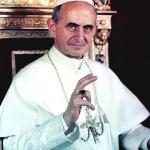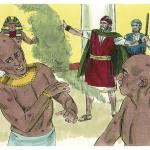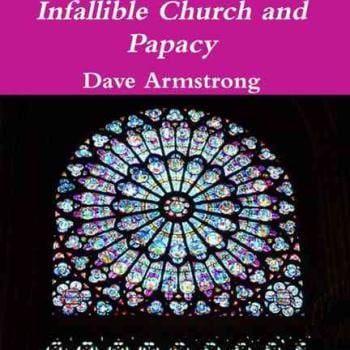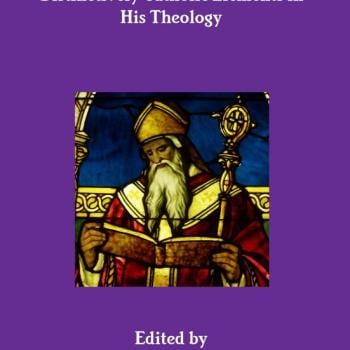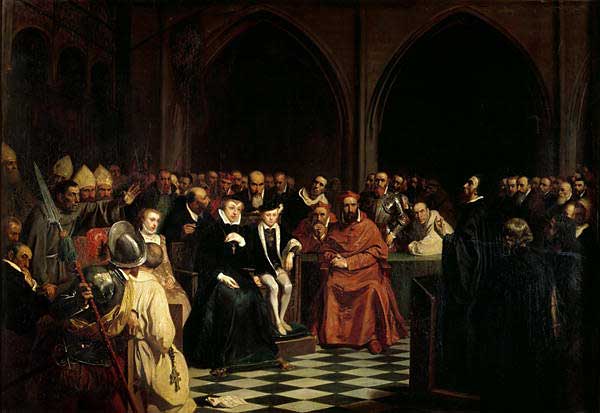
(4-27-04)
***
Catholic historian Warren Carroll writes:
Reform-minded Cardinal Contarini attended the Diet of Regensburg and its religious discussions, and managed to obtain agreement on both sides on a statement on justification, but only by using a new concept of “duplicate justice,” which recognized that God gave justifying grace to men in baptism, but also stated that “a yet higher justice, that of Christ Himself, becomes necessary in order to attain a perfect renewal, this latter being given and imputed to men through faith.” It seemed an inspired straddle, but the Council of Trent later repudiated it [Dave: Luther had refused to accept it also]. Jubilation over this paper harmonization . . . soon faded when the conferees took up their differences on the Mass and the sacraments, which were absolutely irreconcilable. The Catholic Faith cannot be practiced without the Mass, and the Protestants had totally rejected the Mass. Just a week after the illusory agreement on justification, Cardinal Contarini wrote that he had been astonished to discover that the Protestants rejected both the Real Presence and veneration of the Blessed Sacrament outside Mass. On May 16 Contarini wrote to Rome: . . . “strife proceeds neither from the Holy See nor from the Emperor, but from the obdurate adherence of the Protestants to their errors.” (The Cleaving of Christendom [A History of Christendom, vol. 4], Front Royal, Virginia: Christendom Press, 2000, 179)
Noted Protestant Church historian Roland Bainton wrote about the same diet:
Protestants and Catholics were in attendance and the purpose was to see whether accord could be achieved. There was some real hope because the leader of the Catholic side was Cardinal Contarini, one of the Italian liberals of the Erasmian brand, and the leader on the Protestant side was Martin Bucer of Strasbourg, noted for his mediatory role between the Swiss and the Lutherans. The cardinal doctrine of Luther, justification by faith, proved after all not to be an insuperable obstacle because Contarini was ready to accept it, though whether he meant by it precisely what the Lutherans did is another matter. But the Protestant rejection of transubstantiation was more serious and Bucer, unlike Melanchthon at Augsburg, was very insistent on the rejection of papal authority. Union failed . . . (The Reformation of the Sixteenth Century, Boston: Beacon Press, 1952, 152)
So we see that the Catholic side was willing to “compromise” on the Protestants’ leading (“cardinal”) concern: justification, but the Protestants would not flinch on matters of supreme importance and “non-negotiability” for the Catholics: transubstantiation and papal authority. We see almost the same exact dynamic and Protestant inflexibility at the Colloquy of Poissy in 1561. Carroll describes that event:
A group of French Calvinists headed by Theodore Beza had been invited to present the case for their religion to the bishops assembled to prepare for the Council of Trent . . . the government made public a series of edicts drawn up three weeks earlier, which while continuing to forbid public Calvinist worship, allowed it in private homes, recommended that judges be more lenient with Calvinists, and granted a general amnesty to those in prison charged with heresy.
. . . The colloquy itself began September 9 with another speech by [Chancellor] l’Hopital urging religious unity and pledging that the government would no longer persecute the Calvinists. But . . . the Colloquy of Poissy was no exercise in “ecumenism.” Even less than the Lutherans were the Calvinists interested in ecumenism, Like all revolutionaries, they would accept it only on their own terms. On this first day of discussion Beza threw down the gauntlet with the explicit and shocking denial of the Real Presence . . .:
If we regard the distance of things (as we must, when there is a question of His corporeal presence, and of His humanity considered separately), we say that His body is as far removed from the bread and wine as is heaven from earth. [September 9, 1561]
. . . The Real Presence, like the Incarnation, is a doctrine on which there can be no compromise for a serious Catholic . . . Still Catherine de Medici and l’Hopital set up a committee of twelve Catholics and twelve Calvinists to continue the discussions. In a meeting of this committee, Beza attacked the doctrine of papal primacy and papal succession from Peter, using the absurd fable of “Pope Joan” to support his argument, and denied that Scripture depended on the authority of the Church or that there was any infallible source of religious truth. Catholic theologian l’Espence responded by pointing out that the Calvinist ministers lacked any claim to authority whatsoever. By now the discussion had degenerated into a shouting match . . . Efforts to find a compromise formula of language for the Real Presence were torpedoed by Peter Martyr Vermigli, a radical Calvinist . . . (Carroll, ibid., 281-283; Beza citation from p. 235)
Bainton practically agrees with Carroll’s implication that any hope of conciliation was destroyed by Protestant intransigence:
Theodore Beza was given unrestricted opportunity to state the Protestant case. In so doing he not only failed to conciliate the Catholics but succeeded also in alienating the Lutherans by stating in the baldest terms the Calvinist doctrine of spiritual communion only in the Lord’s Supper, seeing that the body of Christ is as far from the bread and wine as heaven from earth. Agreement on any such basis was of course out of the question. (Bainton, ibid., 167-168)
Noted Protestant historian Phillip Schaff, in his History of the Christian Church (1910 edition of Charles Scribner’s Sons, vol. 8, ch. 19, § 170. “Beza at the Colloquy of Poissy”), describes the scene:
He then addressed the assembly upon the points of agreement and of disagreement between them, and was quietly listened to until he made the assertion that the Body of Christ was as far removed from the bread of the Eucharist as the heavens are from the earth. Then the prelates broke out with the cry “Blasphemavit! blasphemavit!” (“he has blasphemed”), and for a while there was much confusion. Beza had followed the obnoxious expression with a remark which was intended to break its force, affirming the spiritual presence of Christ in the Eucharist; but the noise had prevented its being heard. Instead, however, of yielding to the clamor the queen-mother insisted that Beza should be heard out, and he finished his speech.
The tragedy of these so-called “ecumenical” gatherings (at least from my admittedly biased Catholic perspective) is twofold. First of all, we observe Protestant utter intolerance of various Catholic doctrines, held for many hundreds of years and passed down in apostolic Tradition, so that compromise (or even agreement to disagree) is made impossible by definition right from the outset (Bucer and Beza).
Why, then, even attempt a dialogue, if the Protestants went into these meetings determined to not agree with or even allow any Catholic doctrine which they rejected? Reconciliation and whatever compromise is possible (without either party forsaking their own principles and deepest beliefs) is a two-way street, after all.
It may very well be (I suspect it probably was the case) that the Catholics were just as inflexible and stubborn, but certainly no more so than the Protestants. So any implication that the Protestants were all for freedom of religion and tolerance (either far more than the Catholics, or exclusively) is simply false to history.
Somewhat ironically, the second pronounced Protestant fault in these “ecumenical” gatherings was equivocation and astonishingly two-faced proclamations (such as those of Melanchthon at Augsburg in 1530 — see my paper, The Real Diet of Augsburg vs. the Protestant Myth)
John Calvin wrote a fascinating letter which dealt with events shortly before the Diet of Regensburg and proves once again the first Protestant tendency mentioned above: equivocation in negotiations with Catholics (this time by both Bucer and Melanchthon). Phillip Schaff introduces it:
Calvin . . . gave a decided judgment in Latin against transubstantiation, which he rejected as a scholastic fiction, and against the adoration of the wafer which he declared to be idolatrous. He was displeased with the submissiveness of Melanchthon and Bucer, although he did not doubt the sincerity of their motives. He loved truth and consistency more than peace and unity. “Philip,” he wrote to Farel (May 12, 1541), “and Bucer have drawn up ambiguous and varnished formulas concerning transubstantiation, to try whether they could satisfy the opposite party by giving them nothing [Schaff footnote: These formulas are printed in Melanchthon’s Epistolae, IV. 262-264]. I cannot agree to this device, although they have reasonable grounds for doing so; for they hope that in a short time they would begin to see more clearly if the matter of doctrine be left open; therefore they rather wish to skip over it, and do not dread that equivocation (flexiloquation) than which nothing can be more hurtful. I can assure you, however, that both are animated with the best intentions, and have no other object in view than to promote the kingdom of Christ; only in their method of proceeding they accommodate themselves too much to the times …. These things I deplore in private to yourself, my dear Farel; see, therefore, that they are not made public. One thing I am thankful for, that there is no one who is fighting now more earnestly against the wafer-god [Schaff footnote: Or, in-breaded God, impanatus Deus], as he calls it, than Brentz.”
(n Schaff, ibid., vol. 8, ch. 11, § 89; the entire letter is also published in Selected Works of John Calvin: Tracts and Letters: Letters, Part 1, 1528-1545, vol. 4 of 7; edited by Jules Bonnet, translated by David Constable; Grand Rapids, Michigan: Baker Book House (a Protestant publisher), 1983, 262-264; reproduction of Letters of John Calvin, vol. 1 [Philadelphia: Presbyterian Board of Publication, 1858] )
For any progress to have taken place, both parties needed to be straightforward and honest with each other. Equivocation was not the route to success, because it would only backfire later, when the true nature of Protestant beliefs became apparent. Nor is total inflexibility. Both sides were inflexible, granted, but a major difference between the two is the fact that the Catholic beliefs had been held for many centuries, whereas the Protestant beliefs on things like the Eucharist were new and novel.
Along these lines, the Protestant historian Thomas Babington Macaulay wrote, in a remarkable passage in one of his Critical and Historical Essays:
The immediate effect of the Reformation in England was by no means favourable to political liberty. The authority which had been exercised by the Popes was transferred almost entire to the King. Two formidable powers which had often served to check each other were united in a single despot. If the system on which the founders of the Church of England acted could have been permanent, the Reformation would have been, in a political sense, the greatest curse that ever fell on our country. But that system carried within it the seeds of its own death. It was possible to transfer the name of Head of the Church from Clement to Henry; but it was impossible to transfer to the new establishment the veneration which the old establishment had inspired. Mankind had not broken one yoke in pieces only in order to put on another. The supremacy of the Bishop of Rome had been for ages considered as a fundamental principle of Christianity. It had for it everything that could make a prejudice deep and strong, venerable antiquity, high authority, general consent. It had been taught in the first lessons of the nurse. It was taken for granted in all the exhortations of the priest. To remove it was to break innumerable associations, and to give a great and perilous shock to the principles. Yet this prejudice, strong as it was, could not stand in the great day of the deliverance of the human reason. And it was not to be expected that the public mind, just after freeing itself by an unexampled effort, from a bondage which it had endured for ages, would patiently submit to a tyranny which could plead no ancient title. Rome had at least prescription on its side. But Protestant intolerance, despotism in an upstart sect, infallibility claimed by guides who acknowledged that they had passed the greater part of their lives in error, restraints imposed on the liberty of private judgment at the pleasure of rulers who could vindicate their own proceedings only by asserting the liberty of private judgment, these things could not long be borne. Those who had pulled down the crucifix could not long continue to persecute for the surplice. It required no great sagacity to perceive the inconsistency and dishonesty of men who, dissenting from almost all Christendom, would suffer none to dissent from themselves, who demanded freedom of conscience, yet refused to grant it, who execrated persecution, yet persecuted, who urged reason against the authority of one opponent, and authority against the reasons of another. Bonner acted at least in accordance with his own principles. Cranmer could vindicate himself from the charge of being a heretic only by arguments which made him out to be a murderer.
Thus the system on which the English Princes acted with respect to ecclesiastical affairs for some time after the Reformation was a system too obviously unreasonable to be lasting. (“John Hampden,” December 1831)
In other words, it was far more objectionable for the Protestants to be totally dogmatic about their “new stuff” than for Catholics to be totally dogmatic about their “old stuff.”
***
Photo credit: Colloquy of Poissy (1840), by Joseph-Nicolas Robert-Fleury (1797-1890) [public domain / Wikimedia Commons]
***


